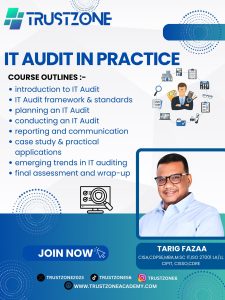

Course Outline: IT Audit in Practice
Module 1: Introduction to IT Auditing
– Overview of IT Auditing
– Definition and importance
– Key objectives and benefits
Types of IT Audits
– Compliance audits
– Operational audits
– Financial audits
– Integrated audits
Module 2: IT Audit Frameworks and Standards
† †Common Frameworks
† † † – COBIT
† † † – ISO/IEC 27001
† † † †- NIST Cybersecurity Framework
†† Regulatory Requirements
† † †- GDPR
† † †- HIPAA
† † † – SOX
Module 3: Planning an IT Audit
† †Audit Planning Process
† † – Establishing the audit scope and objectives
† † – Risk assessment and prioritization
† †Developing an Audit Plan
† † – Resource allocation
† † – Timelines and milestones†
Module 4: Conducting an IT Audit
† † Audit Methodologies
† † † – Data collection techniques
† † † – Interviewing stakeholders
† † † – Document review
† † Testing and Evaluation
† † † – Control testing
† † † – Evidence collection
† † † – Assessing compliance with policies and procedures
Module 5: Reporting and Communication
† † † Audit Reporting
† † † – Structure of an audit report
† † † – Key findings and recommendations
† † † Effective Communication
† † † – Presenting findings to stakeholders
† † † – Following up on audit recommendations
Module 6: Case Studies and Practical Applications
† † †Real-world IT Audit Case Studies
† † † †- Analysis of successful audits
† † † †- Lessons learned from failures
† † † Hands-on Exercises
† † † – Simulated audit scenarios
† † † – Role-playing exercises
Module 7: Emerging Trends in IT Auditing
† † †Technology and IT Audit
† † †- Impact of AI and machine learning
† † †- Cybersecurity considerations
† † Future of IT Auditing
† † † – Trends and challenges in the industry
†Module 8: Final Assessment and Wrap-up
† † Capstone Project
† † † – Conducting a mini-audit
† † † – Presenting findings
† †Course Review and Feedback
† † †- Summary of key concepts
† † †- Course evaluation
† † Additional Resources
† † †- Recommended readings and online resources
† † †- Professional certifications in IT auditing (e.g., CISA, CISM)
This outline can be adjusted depending on the audience’s level of expertise and specific interests


